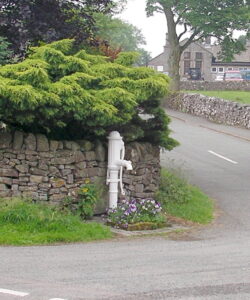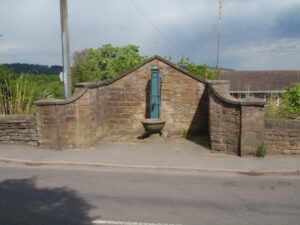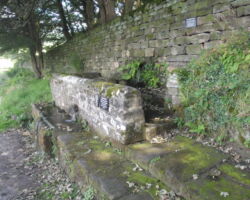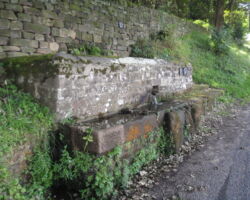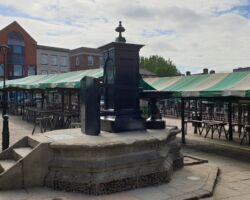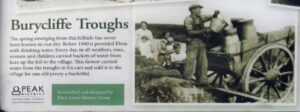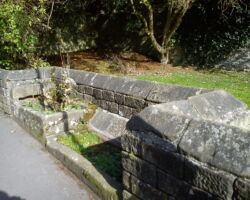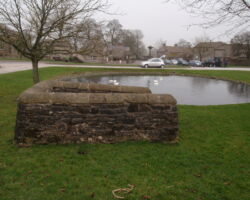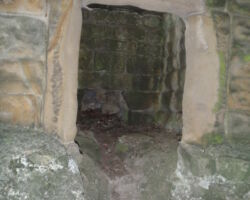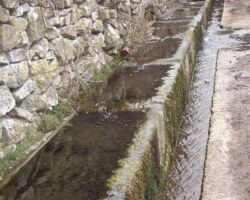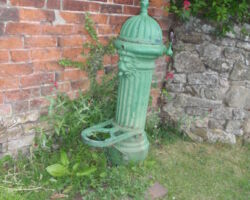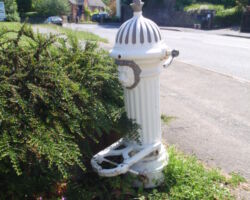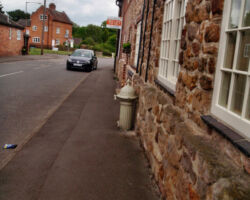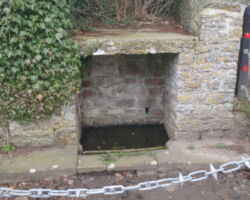Derbyshire Water Sources
Water wells were dug to access groundwater from underground aquifers, the well water being drawn up by a pump or bucket.
A hand pump opened up access to deeper groundwater that, unlike river water, was often not polluted. It also protected the quality of well water source from contamination when buckets were used.
The history of water pumps goes back to Greece around 250BC and the remains of a wooden Roman pump have been found at Silchester. Lead pumps were common and more durable than wood, but most of the pumps that survive today are nineteenth century cast iron pumps.
A hand-powered water pump, or ‘pitcher pump’, was commonly installed over community water wells in the days before piped water supplies.
The Public Health (Water) Act of 1878 stated that it was the responsibility of each parish, “to see that occupied dwelling-house within their district, has within a reasonable distance an available supply of wholesome water sufficient for consumption and use for domestic purposes of the inmates of the house.“
Thus many pumps were installed and they became a local focal point where people gathered.
It was often called the parish pump and although community pumps are no longer common, people still used the expression parish pump to describe a place or forum where matters of local interest were discussed.
These pumps were respected and looked after and some activities like cleaning fish or taking water for cattle were not allowed. Obviously, it was a huge problem in the life of a village if the pump broke down or froze so they were regularly maintained.
The following is a small selection of the pumps and other water sources and troughs in Derbyshire.
Alstonefield – Green Well
Ashover – Cripton well
Ashover – parish pump
Barlborough – Town well
Barlow – pump
Baslow – Lady Wall Well
Birchover – Mires trough
Bolsover – conduit, watch or cundy house
Bradford Dale Spring water pump
Chatsworth park – animal water troughs
Chelmorton – Illy Willy water
Chesterfield – market pump
Elton – Burycliffe troughs
Eyam – troughs
Foolow – well
Hardwick Hall – St Mary’s well
Ible – Twelve Apostles
Longshaw – broken trough
Matlock – Allenhill spaw
Oker – Grace’s well
Old Dam – pump
Over Haddon – village pump
Rowsley – Peak well
Stoney Middleton – village pump
Taddington – High well
Taddington Moor High mere
Ticknall water supply
Tissington – 6 wells
Tissington School – large trough
Upper Padley – trough
Youlgrave – The Fountain
Well near Brough
Wessington well
Whatstandwell – water supply
from the information board –
Alstonefield lies on a limestone plateau where water readily drains away. Natural supplies of water are few and far between.
Green Well was the original main source of domestic water for Alstonefield Village. With a steadily increasing
population Green Well was eventually unable to cope with the extra demand for water. In the mid 19th century the Harpur-Crewe Estate built two reservoirs (totalling some 70,000 galls capacity) for use by the village.
The reservoirs collected water from the area known as ‘The Clays’. This was a pocket of clay soil lying in the fields behind you. Clay was also extracted from here-to line local ‘dew ponds’ to provide valuable watering holes for use by cattle and sheep. Local people drew their water from the reservoirs using the village pump (still to be seen.at the road junction, some 50 yards to your left). During dry summer it was quite common for the reservoirs to have dangerously low water levels, or even run totally dry.At such times very strict rationing was introduced. The pump was locked up and villagers were only able to collect water at certain times of the day. In these dry times Green Well was once again utilised, and the older members of the community can clearly remember going with their parents to draw water for household use.
Another valuable source of water for the household was the rainwater collected in a water butt – one of which was to be seen outside every house.
Green Well and the Reservoirs continued to be used until mains water eventually arrived in the village in 1957. As they were no longer required the reservoirs were filled in and in 1957 the house Called ‘Dove Fold’ was built on the site.A full account of the history of Alstonefield and its water supply can be found in the book called ‘Alstonefield Memories’ published by Alstonefield Local History Society.
Ashover – Cripton well on Cripton Lane is said to never run dry. It is now overgrown and difficult to find – just listen for running water. It is said that at one time more water was drawn and drunk from this well than from anywhere else in Ashover. It was so popular and with supposed health-giving powers the residents from Ashover’s two hydropathic establishments trekked up to the well to take the waters.
Barlborough – Town well
In the 1800’s Barlborough was classified as a town. The ‘Well’ was a most important source of water, and it’s source is a spring that rises in Barlborough Park. One of the stone troughs was thought to be an ancient font. A large and a small round trough were removed from the well site and are now housed in the church porch.

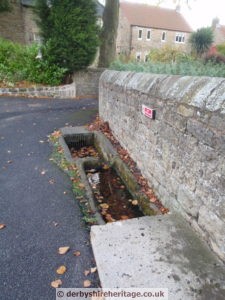
Bolsover – conduit, watch or cundy house’
Listed in Historic England, British Listed Buildings, Experience Peak district & Derbyshire, English Hertitage and Bolsover Town Council.
The name ‘Cundy’ is a corruption of the French word ‘conduit’, or water pipe.
The Cundy House was built in the early 17th century to provide a water supply for Bolsover Castle, about 300 metres (328 yards) away.The name ‘Cundy’ is a corruption of the French word ‘conduit’, or water pipe.
Conduit houses were built for a number of country houses in this period. Usually unmanned and remote from the building they served, they had to be strong and secure, to protect the water supply from pollution by animals or from other interference. Four other smaller conduit houses were constructed about the same time along the ridge line on the far side of the castle.
A town guide shows the location.
Chatsworth park – animal water troughs
There are several water troughs dotted about the park to provide for the many park animals.
Chelmorton – Illy Willy Water – The Chelmorton Troughs The troughs are the last remaining pair of seven, which were located down the west side of main street with one on the east side near Town End. The water originates from a spring at the foot of Chelmorton Low and originally ran as a stream known as Illy-Willy-Water. When the troughs were installed, they were connected by gritstone channels to improve flow, which ended at “Chelmorton Docks” before disappearing down a “swallet” hole at Town End. The villagers began modernising their water supply in the late 19th century by installing a header tank and piping the water to houses and farms. The Illy-Willy-Water now runs underground and the village supply is from Ladybower.
The troughs are the last remaining pair of seven, which were located down the west side of main street with one on the east side near Town End. The water originates from a spring at the foot of Chelmorton Low and originally ran as a stream known as Illy-Willy-Water. When the troughs were installed, they were connected by gritstone channels to improve flow, which ended at “Chelmorton Docks” before disappearing down a “swallet” hole at Town End. The villagers began modernising their water supply in the late 19th century by installing a header tank and piping the water to houses and farms. The Illy-Willy-Water now runs underground and the village supply is from Ladybower.
Chesterfield – market pump
Early/mid 19thc may be earlier. The well was sunk to a depth of about 11 metre. John Wesley spoke from the ‘town pump’ in 1777.
A plaque reads –
“TOWN PUMP”
The town pump was designed by local surveyor
Samuel Rollinson
It was erected in 1853 for the benefit of townsfolk and market traders.
The well was sunk to a depth of about 11 metres.
Water carts carried water from the pump to other
locations within the town.
The pump was sometimes used as a platform for public speaking.
It is now ‘listed’ as a structure of special architectural and
historic interest, grade II.
 The Peak District National Park Authority notice board reads –
The Peak District National Park Authority notice board reads –
“The spring emerging from this hillside (Anthony Hill) has never been known to run dry. Before 1940 it provided Elton with drinking water. Every day, in all weathers, men, women and children carried buckets of water from here up the hill to the village. This farmer carried water from the troughs in his cart and sold it in the village for one old penny a bucketful.”
Hardwick Hall – St Mary’s Well
At Hardwick Hall on the South side of the Old Hall is the stone arched canopy that was St. Mary’s Well. The canopy once supported a lead cistern which was filled by a pump. From here the water in the cistern fed by gravity to the hall in lead pipes to supply two further cisterns in the Low Larder. An inventory of 1601 refers to these ‘sesterns of lead’. Servants carried the water from these cisterns throughout the house.
Today we take our water supply for granted and cannot imagine the effort involved in transporting all the water necessary for the upkeep of such a large household by hand.
However, as part of a number of improvements to the estate, Thomas Crump of Derby was asked to provide a steam engine to pump water to the New Hall and a pump hose with its tall detached chimney was built with stone from the Hardwick quarries in 1859.
Ible – Twelve Apostles
This row of troughs known locally as the Twelve Apostles stand in the little hamlet of Ible above the Via Gellia. The cottage nearby was once a Methodist Chapel so perhaps that is where the troughs have a connection. Ible only consists of a few farms and cottages.
There does not seem to be a record of a packhorse route here but it seems like a lot of troughs just for local use.
Longshaw – broken trough – this must have been so annoying – almost complete then a crack appears.
Matlock – AllenHill Spaw
Just off the A6 Bakewell road at Matlock is a small stone surround to the outlet of a disused mineral spring dating to 1893.
The inscription reads 1821, Allenhill Spa Restored. The water comes from the Chalybeate spring which is rich in iron, hence the orange-brown colour. SK296604

Oker – Grace’s well
In a walled enclosure near Oker at SK277611 is Grace’s Well.
It is in a good state of repair and has presumably been restored in fairly recent times as there is a name plaque on the wall. Entrance to the well is through two substantial gateposts.
Over Haddon – village pump
Found on Watergate Lane near the Lathkill Hotel which was originally known as The Miners Arms.
from The Lathkill Hotel website –
There has been a public house here since the early 1880s. The first records relating to The Lathkil Hotel’s history date back to 1828, when John Wildgoose was landlord of The Miners Arms Hotel. The pub was then used for much-needed refreshment by the lead miners working in Lathkill Dale. Indeed, in the 1850s, it was even owned by the local mining agent, James Bateman. In 1882, Ester Wildgoose changed the name to The Lathkil View Hotel. With extensions and names changes over the past two centuries the hotel is known today as The Lathkil Hotel.
Rowsley – The Peak Well or village fountain at Rowsley is located opposite the Peacock Hotel in Church Lane. It was carved towards the end of the nineteenth century by Trevis Bath who also carved the stone peacock above the front porch of the Peacock Hotel.
Stoney Middleton – village pump
Taddington’s High Well is an uphill walk from the village centre. It was restored after years of neglect following connection of the village to a mains water supply.
Taddington moor high mere is located half a mile south of Taddington at 1200 ft above sea level.
From the information board –
The earliest documented record of a mere is on the map of ‘The Wastes and Commons of Taddington and Priestcliffe’, surveyed by John Orme in 1690 – ‘the great pond or meare called Taddington high Meare’

The mere lies at a meeting of track ways and would have been an important watering place for sheep, cattle and pack horses on the desolate moors where free standing water was scarce.
South-east of the mere, Wades Cross was an important marker to guide travellers and packhorse trains over Sheldon and flagg moors, up to High Mere and then down to Taddington and on to Tideswell.
The trackway adjacent to the mere was the subject of a boundary dispute between Taddington and Flagg in 1795, when it was referred to in the Taddington and Pristcliffe Enclosue Award as ‘a certain ancient way called Oriss road’.
The High Mere is a geological feature formed during the ice age. Glaciation scalped the top layers off the local topography, typically, folded layers of limestone, basalt and clays to reveal small pockets of clay deposits scattered over the upland limestone plateau. These formed small ponds or meres when filled with abundant rainwater.
Ticknall – A public water supply was installed on the instruction of Sir Vauncey Harpur-Crewe of Calke Abbey in 1914
Piped water was introduced to the village in the 1950s
The pillar fountains are Grade II Listed and were manufactured by Glenfield and Kennedy Ltd of Kilmarnock. The Fountains were fed by gravity from a reservoir filled with water drawn from a well by wind-pump.
More detail about the Ticknall Water Spouts can be found in a Ticknall Life article.
Tissington School – large trough
Upper Padley – trough
In a remote place, north of Bolehill quarry – was it for packhorses taking stone from the quarry?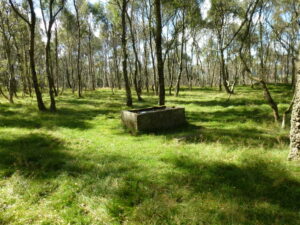
Youlgrave – Fountain
In the centre of the market place is a huge circular water tank or conduit head, known locally as The Fountain. Since 1829 this supplied soft water to the villagers, initially at an annual charge of 6d. It was built following a campaign by the ‘Friendly Society of Women’, who demanded a cleaner, healthier and more efficient supply of water and was infinitely better than carrying the water up from Bradford Dale.
Erected in 1829, known locally as “The Fountain” and having a capacity of 1500 gallons of water. It was built, from local gritstone, by Edward Twyford at a cost of £31.10s., to provide a head of water when a public supply was first brought to the village. The height of the first spring was 630 feet above sea level and the base of the tank was 605 feet, thus allowing a 25 feet head of water. The cost to the villagers was 6d. per annum and water could be obtained between 6 am. and 6 pm. daily when access to the single tap was unlocked by the overseer. The erection of the “fountain” marked the culmination of a campaign by local women, led by Miss Hannah Bowman, who had previously been obliged to lug water up from the River Bradford, which was really too hard for wash day. Softer water was piped from the Mawstone Spring, across the valley. In later years, water was piped to street taps and eventually into people’s homes.
The supply deteriorated due to the rotting and collapse of the pipe, and it was decided to lay a new one, this time from a different spring in Bleakley Wood (SK.217629) near to Mawstone Spring. The cost of this was estimated as £400, a considerable sum for a small village to raise in the 1860’s. Four local benefactors came to the rescue and the men in the village were required to do the digging, ‘and he who could not do his share paid another man to do it for him’. On 27th July 1869, a second opening ceremony was held at the same stone tank, followed by celebrations on a grand scale. There was a public dinner for 300 persons in the new schoolroom, 400 children marched behind the Matlock Brass Band, and it all finished with a great public tea.
Well near Brough
Opposite the Traveller’s Rest (SK184828) at the junction of the B6049 and A625 is a well. It is walled round, with a flight of steps descending to the water level. It was clearly designed to admit people only and not animals, so watering the latter must have been a laborious undertaking using buckets.
Wessington well

A plaque fixed to the well tells its history –
THIS FORMER WORKING WORKING WELL
WAS REOPENED TO CELEBRATE
MILLENIUM 2000
THE WELL SUPPLIED WATER FOR MANY
YEARS BUT FELL INTO DISUSE WHEN
THE MAINS SUPPLY REACHED THIS
PART OF THE VILLAGE
OPENED BY GLADWIN TURBUTT
HIGH SHERIFF OF DERBYSHIRE 1908-1999
ON THE 25TH SEPTEMBER 1999

